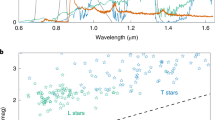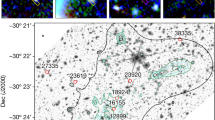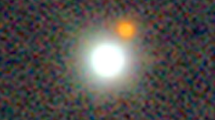Abstract
The fraction of ionized hydrogen left over from the Big Bang provides evidence for the time of formation of the first stars and quasar black holes in the early Universe; such objects provide the high-energy photons necessary to ionize hydrogen. Spectra of the two most distant known quasars1 show nearly complete absorption of photons with wavelengths shorter than the Lyman α transition of neutral hydrogen, indicating that hydrogen in the intergalactic medium (IGM) had not been completely ionized at a redshift of z ≈ 6.3, about one billion years after the Big Bang. Here we show that the IGM surrounding these quasars had a neutral hydrogen fraction of tens of per cent before the quasar activity started, much higher than the previous lower limits1,2 of ∼0.1 per cent. Our results, when combined with the recent inference of a large cumulative optical depth to electron scattering after cosmological recombination3 therefore suggest the presence of a second peak in the mean ionization history of the Universe.
This is a preview of subscription content, access via your institution
Access options
Subscribe to this journal
Receive 51 print issues and online access
$199.00 per year
only $3.90 per issue
Buy this article
- Purchase on Springer Link
- Instant access to full article PDF
Prices may be subject to local taxes which are calculated during checkout


Similar content being viewed by others
References
White, R. L., Becker, R. H., Fan, X. & Strauss, M. A. Probing the ionization state of the universe at z > 6. Astron. J. 126, 1–14 (2003)
Fan, X. et al. Evolution of the ionizing background and the epoch of reionization from the spectra of z ∼ 6 quasars. Astron. J. 123, 1247–1257 (2002)
Kogut, A. et al. First-year Wilkinson microwave anisotropy probe (WMAP) observations: temperature-polarization correlation. Astron. J. Suppl. 148, 161–173 (2003)
Hu, E. M. et al. A redshift z = 6.56 galaxy behind the cluster Abel 370. Astrophys. J. 568, L75–L79 (2002)
Haiman, Z. The detectability of high-redshift Lyα emission lines prior to the reionization of the universe. Astrophys. J. 576, L1–L4 (2002)
Willott, C. J., McLure, R. J. & Jarvis, M. J. A 3 × 109 M⊙ black hole in the quasar SDSS J1148 + 5251 at z = 6.41. Astrophys. J. 587, L15–L18 (2003)
Walter, F. et al. Molecular gas in the host galaxy of a quasar at redshift z = 6.42. Nature 424, 406–408 (2003)
Richards, G. T. et al. Broad emission-line shifts in quasars: an orientation measure for radio-quiet quasars? Astron. J. Suppl. 124, 1–17 (2002)
Barkana, R. & Loeb, A. In the beginning: the first sources of light and the reionization of the universe. Phys. Rep. 349, 125–238 (2001)
Gunn, J. E. & Peterson, B. A. On the density of neutral hydrogen in intergalactic space. Astrophys. J. 142, 1633–1641 (1965)
Pentericci, L. et al. VLT optical and near-infrared observations of the z = 6.28 quasar SDSS J1030 + 0524. Astron. J. 123, 2151–2158 (2002)
Martini, P. QSO lifetimes. Preprint at 〈http://arXiv.org/astro-ph/0304009〉 (2003).
Miralda-Escude, J., Haehnelt, M. & Rees, M. Reionization of the inhomogeneous universe. Astrophys. J. 530, 1–16 (2000)
Barkana, R. & Loeb, A. GRBs versus Quasars: Lyman-α signatures of reionization verses cosmological infall. Astrophys. J. (in the press); preprint at 〈http://arXiv.org/astro-ph/0305470〉 (2003)
Shapiro, P. R. & Giroux, M. L. Cosmological, H II regions and the photoionization of the intergalactic medium. Astrophys. J. 321, L107–L112 (1987)
Cen, R. & Haiman, Z. Quasar Stromgren spheres before cosmological reionization. Astrophys. J. 542, L74–L78 (2000)
Madau, P. & Rees, M. J. The earliest luminous sources and the damping wing of the Gunn-Peterson trough. Astrophys. J. 542, L69–L73 (2000)
Telfer, R. C., Zheng, W., Kriss, G. A. & Davidsen, A. F. The rest-frame extreme-ultraviolet spectral properties of quasi-stellar objects. Astron. J. 565, 773–785 (2002)
Elvis, M. et al. Atlas of quasar energy distributions. Astron. J. Suppl. 95, 1–68 (1994)
Shields, G. A. et al. The black hole-bulge relationship in quasars. Astrophys. J. 583, 124–133 (2003)
Ferrarese, L. Beyond the Bulge: a fundamental relationship between supermassive black holes and dark matter halos. Astrophys. J. 587, 90–97 (2001)
Volonteri, M., Haardt, F. & Madau, P. The assembly and merging history of supermassive black holes in hierarchical models of galaxy formation. Astrophys. J. 582, 559–573 (2003)
Yu, Q. & Tremaine, S. Observational constraints on growth of massive black holes. Mon. Not. R. Astron. Soc. 335, 965–976 (2002)
Martini, P. & Weinberg, D. H. Quasar clustering and the lifetime of quasars. Astrophys. J. 547, 12–26 (2001)
Jakobsen, P., Jansen, R. A., Wagner, S. & Reimers, D. Caught in the act: a helium-reionizing quasar near the line of sight to Q0302003. Astron. Astrophys. 397, 891–898 (2003)
Martini, P. & Schneider, D .P. Preprint at 〈http://arXiv.org/astro-ph/0309650〉 (2003).
Wyithe, J. S. B. & Loeb, A. Reionization of hydrogen and helium by early stars and quasars. Astrophys. J. 586, 693–708 (2003)
Cen, R. The implications of Wilkinson microwave anisotropy probe observations for population III star formation processes. Astrophys. J. 591, L5–L8 (2003)
Miralda-Escude, J. Reionization of the intergalactic medium and the damping wing of the Gunn-Peterson trough. Astrophys. J. 501, 15–22 (1998)
Spergel, D. N. et al. First-year Wilkinson microwave anisotropy probe (WMAP) observations: determination of cosmological parameters. Astron. J. Suppl. 148, 175–194 (2003)
Acknowledgements
This work was supported in part by grants from ARC, NSF and NASA.
Author information
Authors and Affiliations
Corresponding author
Ethics declarations
Competing interests
The authors declare that they have no competing financial interests.
Rights and permissions
About this article
Cite this article
Wyithe, J., Loeb, A. A large neutral fraction of cosmic hydrogen a billion years after the Big Bang. Nature 427, 815–817 (2004). https://doi.org/10.1038/nature02336
Received:
Accepted:
Issue Date:
DOI: https://doi.org/10.1038/nature02336
This article is cited by
-
Suppression of dwarf galaxy formation by cosmic reionization
Nature (2006)
-
Out of the Dark Ages
Nature (2004)
-
A characteristic size of ∼10 Mpc for the ionized bubbles at the end of cosmic reionization
Nature (2004)
Comments
By submitting a comment you agree to abide by our Terms and Community Guidelines. If you find something abusive or that does not comply with our terms or guidelines please flag it as inappropriate.



